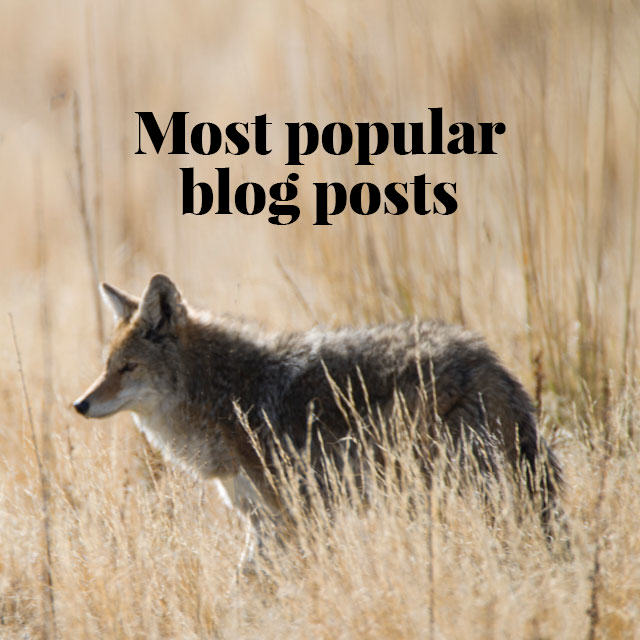
Animal welfare and sustainability are both commendable goals for any company’s strategic plan, but they’re also like chalk and cheese. They’re unrelated, which means you don’t advance one by advancing the other. Yet these days, whenever a designer, brand or retailer announces it is dropping fur supposedly for animal welfare reasons, it also claims this will make it more sustainable. This is totally illogical, and they must be called out for it.
Worse still, the deceit appears to be intentional, not just the result of lazy thinking. In a conscious and cynical bid to associate themselves with two of the hottest buzzwords in marketing today, companies are pitching the message, “We believe in animal welfare and sustainability, so we won’t be using furry animals anymore. (Just don’t ask about all the other ones.)”
So why should the fur trade cry “Foul”? Because sustainability is the strongest argument in favour of fur, and we need to defend it against misuse. Now the debate is being twisted and co-opted to make it appear that fur is the very opposite of sustainable.
First let’s look at sustainability and animal welfare separately, and then see how some sneaky companies pretend they are related.
Sustainability Is One Thing …
Just about every business today claims to be striving for greater sustainability, and with good reason. Not only is it good for the planet, it also sells! It’s something customers want to hear. So even if your business is not sustainable today, at least say you are trying, and promise some vague delivery date like 2030.
For a few lucky industries, including the fur trade, sustainability has already been achieved. Historically, it wasn’t always the case, as some wild species were over-harvested. But with the advent of fur farming and a raft of regulations covering harvest sizes and trade, the modern industry has become a model of sustainability.
Here are its main credentials:
- Furbearers, whether trapped or farmed, are a renewable natural resource.
- No endangered species are used.
- Fur farming provides extra protection for wildlife as production can be adjusted to meet changing demand. (This is true for all livestock farming.)
- Farmed furbearers consume leftovers from the production of human food.
- Trappers provide vital information and assistance to wildlife managers.
- Fur is fully biodegradable, even after processing, no matter what animal rights groups claim.
- A fur garment can last for decades, or be restyled as fashions change. It is the complete opposite of wasteful “fast fashion”.
These credentials look even stronger when you compare real fur to fake fur made from non-biodegradable, non-renewable oil.
… Animal Welfare Is Another
Animal welfare is a different issue entirely. While sustainability is concerned with quantifiable inputs such as reproduction rates and environmental impacts, animal welfare deals with the quality of life and death of the animals we use.
It’s difficult to explain in logical terms how companies bundle animal welfare and sustainability together, because the “logic” they employ is false. They first present an erroneous argument, hope we don’t notice, and then use this argument to justify their business strategy. It’s like saying, “2 + 2 obviously equals 5, we can all agree on that. So now let’s focus on that number 5.”
The false logic they want us to fall for is typically along the following lines. “Treating animals well will result in a kinder and gentler world, which we all want to live in. That world must also be sustainable. Therefore, being kinder to animals is integral to ensuring the future sustainability of our planet. And since it’s impossible to achieve an acceptable level of welfare in the fur trade, the most sustainable option is not to use fur at all.”
QED: Fur is unsustainable.
And when you’ve finished wrestling with the twisted logic, take special note that companies are using it only to justify dropping fur. Not leather. Or feathers. Or any other animal products. For these, it’s business as usual. In other words, the level of animal welfare in producing crocodile handbags or goose down is acceptable, and therefore these products are sustainable. What?
Case Studies
Now let’s look at three real-life examples of fashion companies that have dropped fur, and see the knots they tie themselves in to justify it.
Gucci: In 2017, CEO Marco Bizzarri shocked the fashion world by announcing that his company would be dropping fur. He also announced that Gucci had signed on to the Fur Free Retailer program of the Fur Free Alliance, a group that, in its own words, wants to end the fur trade by “raising the serious animal welfare issues related to fur farming and trapping.” The Alliance expresses no interest whatsoever in promoting sustainability. But still, Bizzarri described Gucci’s move as demonstrating “our absolute commitment to making sustainability an intrinsic part of our business.”
The remarkable thing was that only the fur trade challenged Bizzarri to explain how jumping in bed with an animal rights group and dropping fur would make Gucci more sustainable. The media were all over the dropping fur part, but not one journalist questioned the logic. Why was real fur unsustainable? Was fake fur more sustainable? And why was Gucci not dropping leather, exotic skins and feathers too?
So in one fell swoop, Bizzarri framed Gucci as loving both animals and the planet, and he got away with it.
Nothing has changed since either. If you want to know more about Gucci’s stance on animal welfare, the go-to document is titled – wait for it – Gucci Sustainability Principles! This 21-page document on sustainability refers to animal welfare no fewer than 40 times. And there are three whole pages devoted to the “Kering Animal Welfare Standards” (Kering being Gucci’s parent). Why these in-house, self-serving animal welfare standards belong in a document on “sustainability principles” is not explained, but clearly we are supposed to accept that animal welfare is an integral part of sustainability.
Canada Goose: Known for its iconic performance parkas with coyote trim, Canada Goose is now in a tricky spot PR-wise, largely of its own making. For decades, it was a strong advocate of fur as a sustainable natural resource – an industry leader, in fact. Indeed, a page still on its website but that will presumably disappear soon, states: “We remain committed to the functionality and sustainability of real fur.” Then last June it announced that it was dropping fur.
Observers were in no doubt that this was a response to relentless pressure from animal rights groups, but CEO and president Dani Reiss wasn’t about to admit this. Instead he dug himself a hole, saying, “This decision was driven by our commitment to sustainability …”
So the official line is that Canada Goose is dropping fur voluntarily, as part of its ongoing commitment to sustainability, and you can believe that if you want. But the really tricky part is that it can’t actually say fur is unsustainable, because it’s been saying the polar opposite for years. Which leaves us in the odd position of having to turn off our brains and accept that while fur is sustainable, “fur-free” is more sustainable.
And here’s what it looks like in practice:

This new page on the Canada Goose website sports the headline, “We’re going fur-free”, unquestionably an animal rights slogan with no connection to sustainability. But the subhead reads, “Our desire to evolve into a more sustainable brand continues.” No matter what explanation Canada Goose may have for this, it is impossible for a visitor to this webpage not to connect these two ideas. The message, intentional or not, is clear: Canada Goose is going fur-free BECAUSE it is more sustainable.
Mytheresa: And this quote says it all – no further explanation required. This August 26, the Munich-based luxury retailer announced it would not sell fur beyond 2022. Said CEO Michael Kliger, “At Mytheresa, we believe that sustainability is an important part of our future strategy, and this view is clearly shared by our customers, partners and employees. As we already stopped buying exotic skins in spring 2021, it was clear that going fur-free is the natural next step for Mytheresa. We are proud to be making this change and thank the Humane Society of the United States, Four Paws and the Fur Free Alliance for supporting this policy.”
Each company that drops fur will claim slightly different reasons for equating animal welfare with sustainability, but it always boils down to placing them in the best possible light for consumers. And it looks doubly great if you can check two boxes at the same time!
But it’s all nonsense. Animal welfare and sustainability have as much in common with each other as chalk and cheese. It’s also damaging to businesses that really are sustainable, like the fur trade. And that’s why companies that practice this deception should be called out.
***
To learn more about donating to Truth About Fur, click here.










